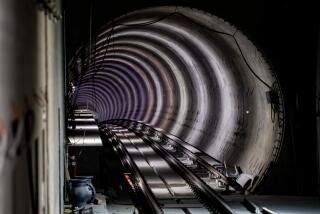Lawyer to Offer Path to Ease Bus Crowding
Before the month is over, a federal mediator is expected to issue guidelines intended to break an impasse between the Metropolitan Transportation Authority and a bus riders group seeking to reduce bus overcrowding.
Washington, D.C., attorney Donald Bliss wants the MTA and the Bus Riders Union to use his guidelines as a roadmap to find a solution to the overcrowding. Among their options: buy more buses or manage bus lines in innovative ways to reduce the number of riders forced to stand.
If the groups can’t find common ground, Bliss will step in once more, deciding on his own what to do.
A gulf separates the two sides. The riders union has long contended that the MTA must put hundreds of new buses on Los Angeles County streets, while the transit authority maintains that its fleet of about 2,300 buses is sufficient.
The dispute started in 1994 when the Bus Riders Union sued the MTA, alleging poor service in minority areas. To avoid a trial, the MTA in 1996 entered into a federal agreement promising to provide better bus service over a 10-year period. While the agency has done much to boost bus service -- it has replaced most of its buses with new vehicles -- it has continually appealed the decree in court and has dragged its feet on following court orders.
After repeatedly being turned away and sternly rebuked by federal appeals court judges, the agency’s last-ditch effort to be heard by the U.S. Supreme Court was turned down in March.
Since the Supreme Court decision, the MTA and Bus Riders Union representatives, who are supposed to monitor the transit agency’s efforts to alleviate overcrowding, have held scores of meetings. Both sides acknowledge they have gotten nowhere.
To help remedy the situation, Bliss has twice come to Los Angeles, meeting with both sides, reviewing finances, taking testimony in court and touring the bus system. On a visit last month, Bliss said he was impressed with the progress the MTA has made in upgrading its fleet, noting that the agency’s new clean-fuel bus fleet is by far the largest in the United States.
But Bliss also said more must be done to eliminate overcrowding.
In recent discussions, the MTA has asked Bliss to recognize that many factors contribute to overcrowding: traffic accidents, rainy streets and special events such as concerts or basketball games. The transit agency says ordering more buses may be a misguided and costly solution.
In an interview last week, MTA Chief Executive Roger Snoble speculated that the final outcome would be a directive for his agency to order “a couple hundred” new buses -- in addition to about 200 buses it already plans to buy.
The riders union, which last week held a small rally at City Hall to begin pressing MTA board member Mayor James K. Hahn to more forcefully back their effort, is calling for 850 buses to be put on the road as soon as possible.
“It’s been five years since we signed an agreement with the MTA, and they are still dragging their feet,” said union co-chair Barbara Lott-Holland. “It’s time they start living up to their promises. If Bliss isn’t going to help, we want Hahn to just step right in and demand the MTA order the buses we so desperately need.”
More to Read
Sign up for Essential California
The most important California stories and recommendations in your inbox every morning.
You may occasionally receive promotional content from the Los Angeles Times.











